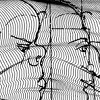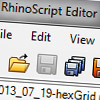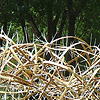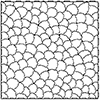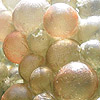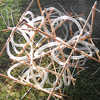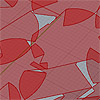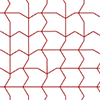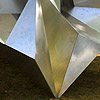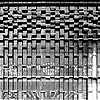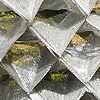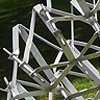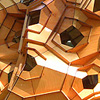In the 14th century, Albrecht Dürer basically seems to capture some of the fundamentals of contemporary parametric design. Apart from other thinkers of his age, he refused to accept one single definition of beauty, based on proportions. His famous physiognomical studies reflected very early examples of referential systems that generate diverse design outputs, even a half-century before Descartes published the coordinate system and four centuries before D’Arcy draw the formal […]
Recently, I returned to old fashion RhinoScripts in order to recapture its idea and functionalities again. After almost 10 years, this is my first experiment on creating a custom function that draws hexagonal grids. I tried to implement a fast process for it, however, there could be much faster ones. This script focuses on using functions, variables, and object arrays. I’ll continue to make more of these simple exercises and […]
After becoming a ready-made component in Grasshopper, the Delaunay triangulation lost its popularity quickly. It used to be a nice problem of computational geometry for designers obsessed with scripting. Last month, Benay reminded me of the method of circle checking. She showed her Rhinoscript that creates circles from point triplets and checks if a point is inside or not. Today I studied this in Grasshopper to see if I can […]
This is another brave group of students. They studied one of the most interesting materials in this year’s Basic Design studio. They tested the structural capacities and nearly all possibilities of thin Bamboo sticks. Unfortunately, they lost most of the prototypes, and one of them was a beautiful structural tripod. In the final assembly, they managed to span the required distance by attaching bamboo sticks using plastic fasteners. Below are […]
Kündekâri is an old woodworking technique, composed of interlocking parts without any glue or nail. It is primarily used in wooden doors and minbers inside Mosques. The interlocking system makes the whole structure very durable. I tried to model this technique using the Voronoi pattern, naming it Voronoi Kündekâri. Below you see a typical example of Kündekâri pieces and the resulting pattern. The interesting part of the Grasshopper model is […]
The material system experienced here is an extreme example of our final projects in İstanbul Bilgi University Faculty of Architecture, first-year Basic Design studio. Students studied fiberglass as their core material and they searched for weeks to find a proper way to expose this material’s potential into a spanning structure. They tried lots of different components, basically using molds to give shape to glass fibers. However, their final decision was […]
Below is another cult article written by Robert Aish in 2005; Design has been described as making inspire decisions with incomplete information. True, we may use prior knowledge, we may even think we understand the causalites involved, but what really matters is exploration: of new forms, of new materials, and speculation about the response to the resulting effects. Essentially, this exploration has its own dynamics, involving intuition and spontaneity, and […]
Here is my 2004 Turkish translation of the popular article “Deleuze and the Use of the Genetic Algorithm in Architecture” by Manuel DeLanda in 2001. The computer simulation of evolutionary processes is already a well established technique for the study of biological dynamics. One can unleash within a digital environment a population of virtual plants or animals and keep track of the way in which these creatures change as they mate and pass […]
Here is the “hose” group of the İstanbul Bilgi University Faculty of Architecture Basic Design project. Although they were challenged with a nearly impossible mission, trying to make a structural system out of hoses, they simply did it well. After a tremendous effort on the possible combinations of hoses and wooden sticks, they found sophisticated components, utilizing the positive potentials of both materials. This year, we allowed them to develop […]
This is based on my failure of creating an optimum solution for planar polygonal subdivisions. There is a method called Tangent Plane Intersection (TPI), explained briefly here (sometimes similar algorithms are called “planar remeshing” and “variational shape approximation”) which is effectively used in the Trada pavilion (here). I tried to implement a similar method using only native Grasshopper components and no recursion, but it quickly became much more complicated than […]
Below is a classical Truchet Patterns example we used to discuss in design computing class. Now, we can create a much faster and cleaner definition using the newly added Array component. The new version of Grasshopper brings several important features: Patch surfaces and date/time components. We used to implement a VB component to create simple clocks that measure temporal operations in Grasshopper. Parsing and executing MusicXML and related applications were […]
Below is one of the fourteen final projects of the freshman year Basic Design studio in İstanbul Bilgi University Faculty of Architecture. The component is made of folded aluminum sheets. Students insist that this is the most optimal solution to the problem of polyhedra in a component-based structure. They experimented with this shape a lot and tried their best to make one that has similar triangular faces on different sides, […]
The story of Atatürk Cultural Center (in Turkish: Atatürk Kültür Merkezi – AKM) dates back to the 1930s. Auguste Perret designed the first version of the project and started the construction in the late ’30s. However, war and financial problems halted the construction. The project continued in the early 1950s with major updates and extensions. Faruk Akçer and Rüknettin Güney were responsible for this second version. Hayati Tabanlıoğlu designed the […]
This group used aluminum expanded mesh in order to test its balance between structural capacity and weight. They folded different-sized sheets to create components, then assembled them creating a span of 2,5 meters approx. They managed to control the macro form by manipulating the component precisely. This year, the dominant discussion among the studio instructors was the context; how to include (or not include), manage, and think about the context, […]
The material system of group 2 at İBU Basic Design project was based on a component developed using tensegrity forces on aluminum bands. Although it was hard to maintain structural solidity with the heavy material, they proved that letting aluminum fly over a predefined distance (at least for a limited time) is possible. *Students: Büşra Kavuk, Büşra Pamuk, Mustafa Sert, Ahmet Evci, Safa Bayam, Sibel Küçükcoşkun, Gizem Işıkalp, Serenay Erbektaş, […]
The following posts will include some of the final projects, completed in Basic Design Studio, İstanbul Bilgi University Faculty of Architecture in 2013. Below, you see the amazing work of group 1, an interlocking system that presents diversity and structural integrity at the same time. This project initiated a hard discussion among the final jury. I think the interesting geometric underlying, great precision for a hand-made computer modeling of each […]
The exploration of the concept of “patronus – pattern” in architecture is presented in a captivating and insightful manner. This issue of AD, although older, continues to hold relevance in the contemporary realm of architectural design, covering various aspects of the conception and utilization of patterns. It’s comprehensive analysis and thought-provoking discourse shed light on the intricate relationship between patterns and architectural form, unveiling the potential for pattern-based design approaches […]

